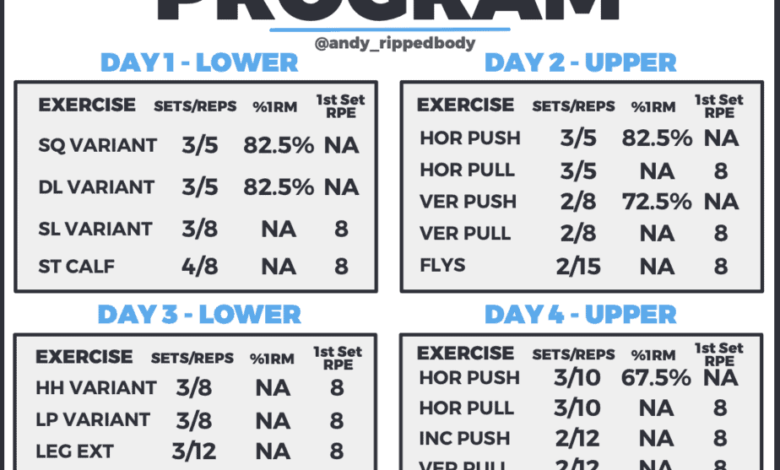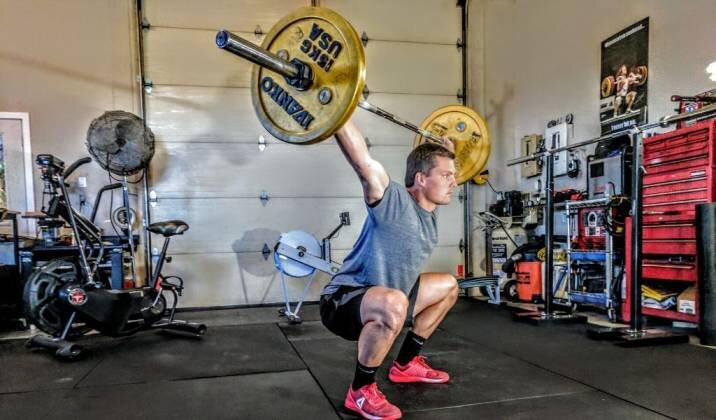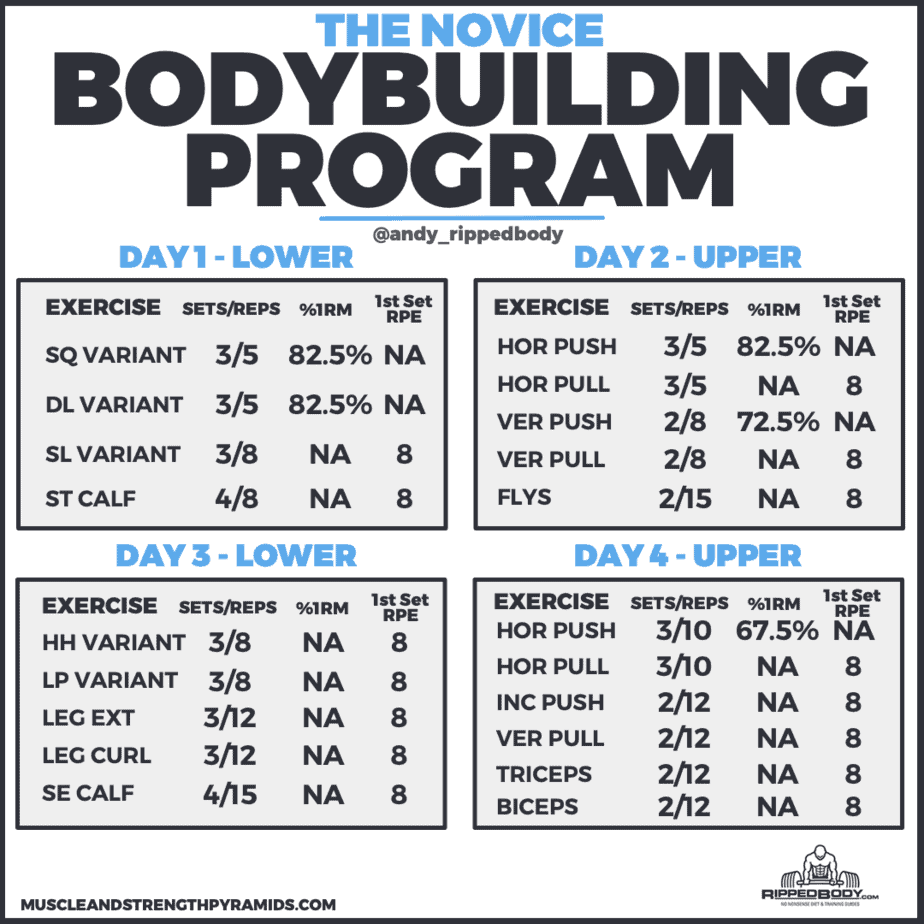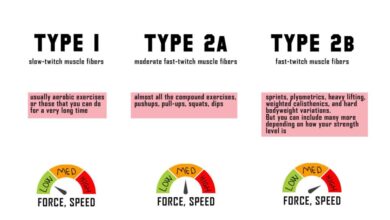
30 Day Beginners Weightlifting Program: Your Path to Strength
Ready to unlock your inner strength? The 30 Day Beginners Weightlifting Program is designed to guide you through a safe and effective journey into the world of weight training. Whether you’re a complete newbie or just looking to reignite your fitness journey, this program offers a structured approach to building muscle, boosting your metabolism, and improving your overall well-being.
No need for fancy equipment or intimidating gyms – we’ll break down the basics and provide you with everything you need to get started.
This program is carefully crafted to accommodate your current fitness level, with beginner-friendly exercises that focus on proper form and gradual progression. We’ll cover everything from exercise selection and weight selection to nutrition and recovery, ensuring you have a solid foundation for success.
So, ditch the excuses, grab your workout gear, and let’s embark on this empowering journey together!
Introduction

Weightlifting is a fantastic activity for beginners, offering a multitude of benefits for your physical and mental well-being. It can help you build strength, improve your cardiovascular health, and increase bone density. However, to reap these benefits safely and effectively, a structured program is essential.
This 30-day beginner’s weightlifting program is designed to guide you through the fundamentals of weightlifting, ensuring a gradual and progressive approach.
Program Purpose and Structure
This 30-day program focuses on introducing you to basic weightlifting exercises, proper form, and gradual progression. It’s structured to cater to beginners, starting with lighter weights and fewer repetitions, gradually increasing both as you gain strength and confidence. The program is divided into three phases, each lasting 10 days:
Phase 1: Foundation Building
The first phase focuses on familiarizing you with basic exercises and establishing proper form. You’ll learn how to perform squats, deadlifts, bench presses, rows, and overhead presses with proper technique. The emphasis is on controlled movements and mastering the form before increasing weight or repetitions.
Phase 2: Strength Development
As you progress, the second phase introduces a slight increase in weight and repetitions, aiming to challenge your muscles and promote strength development. You’ll continue practicing the core exercises from Phase 1, focusing on building a solid foundation of strength.
Phase 3: Maintenance and Progression
The final phase focuses on maintaining the strength you’ve built and gradually increasing the intensity and volume of your workouts. You’ll continue practicing the core exercises, gradually increasing the weight and repetitions while maintaining proper form.
Importance of a Structured Program
A structured weightlifting program is crucial for beginners for several reasons:
Safety and Injury Prevention
A structured program helps prevent injuries by gradually introducing new exercises and increasing weight and repetitions. It allows your body to adapt to the demands of weightlifting, reducing the risk of strains, sprains, or other injuries.
Effective Progression
A structured program ensures you progress at a safe and sustainable pace. It provides clear guidelines for increasing weight, repetitions, and workout frequency, helping you maximize your results while minimizing the risk of plateaus or burnout.
Motivation and Accountability
Having a plan provides structure and motivation, making it easier to stay committed to your weightlifting goals. It also provides accountability, ensuring you’re consistently working towards your objectives and tracking your progress.
Workout Structure
This 30-day beginner weightlifting program is designed to help you build a solid foundation in strength training. It features a structured approach to workouts, ensuring you progress safely and effectively.
Workout Frequency and Duration
The program involves working out three times a week, with rest days strategically placed to allow for muscle recovery and growth. Each workout session will last approximately 45-60 minutes, including warm-up and cool-down periods.
Major Muscle Groups Targeted
The program focuses on targeting all major muscle groups, ensuring balanced development and strength gains. The workouts are divided into three distinct days, each addressing different muscle groups:
- Day 1: Upper Body (Push)– Targets chest, shoulders, and triceps.
- Day 2: Lower Body (Pull)– Focuses on back, biceps, and forearms.
- Day 3: Legs– Concentrates on quads, hamstrings, glutes, and calves.
Progressive Overload and Rest
Progressive overload is a fundamental principle in weightlifting, emphasizing gradually increasing the demands placed on your muscles. This can be achieved by increasing the weight lifted, the number of repetitions, or the sets performed over time.
Progressive overload is crucial for muscle growth and strength gains. It ensures that your body continuously adapts and gets stronger.
Rest is equally important as it allows your muscles to repair and rebuild after strenuous workouts. Adequate rest prevents overtraining and promotes muscle recovery.
- Rest between sets:Take a brief pause of 60-90 seconds between sets to allow your muscles to recover partially before the next set.
- Rest between workouts:Schedule at least one day of rest between each workout session to enable your muscles to fully recover and rebuild.
Exercise Selection
Choosing the right exercises is crucial for a successful weightlifting program. This section will guide you through selecting beginner-friendly exercises for each muscle group, providing variations to challenge different muscle groups and enhance your progress.
Beginner-Friendly Exercises
The following table Artikels a sample 30-day beginner weightlifting program, featuring exercises for each muscle group:
| Day | Exercise | Sets | Reps |
|---|---|---|---|
| Monday | Barbell Squat | 3 | 8-12 |
| Monday | Dumbbell Bench Press | 3 | 8-12 |
| Monday | Dumbbell Row | 3 | 8-12 |
| Monday | Overhead Press | 3 | 8-12 |
| Tuesday | Deadlift | 1 | 5 |
| Tuesday | Barbell Bicep Curl | 3 | 8-12 |
| Tuesday | Tricep Pushdown | 3 | 8-12 |
| Wednesday | Rest | ||
| Thursday | Barbell Squat | 3 | 8-12 |
| Thursday | Dumbbell Bench Press | 3 | 8-12 |
| Thursday | Dumbbell Row | 3 | 8-12 |
| Thursday | Overhead Press | 3 | 8-12 |
| Friday | Deadlift | 1 | 5 |
| Friday | Barbell Bicep Curl | 3 | 8-12 |
| Friday | Tricep Pushdown | 3 | 8-12 |
| Saturday | Rest | ||
| Sunday | Rest |
Exercise Variations
To challenge different muscle groups and prevent plateaus, incorporate exercise variations:
- Squats:Goblet Squat, Front Squat, Bulgarian Split Squat
- Bench Press:Incline Bench Press, Decline Bench Press, Dumbbell Bench Press
- Rows:Bent-Over Row, Seated Row, T-Bar Row
- Overhead Press:Dumbbell Overhead Press, Arnold Press, Lateral Raise
- Deadlift:Romanian Deadlift, Sumo Deadlift, Trap Bar Deadlift
- Bicep Curls:Hammer Curl, Concentration Curl, Preacher Curl
- Tricep Pushdowns:Close-Grip Pushdown, Overhead Tricep Extension, Skull Crushers
Form and Technique: 30 Day Beginners Weightlifting Program
Proper form and technique are essential for effective weightlifting and preventing injuries. It’s crucial to prioritize form over weight, ensuring you move with control and precision. This section will delve into the correct form for each exercise, providing detailed descriptions and visual aids to help you execute each movement safely and efficiently.
Squat
The squat is a fundamental exercise that targets multiple muscle groups, including the quads, glutes, hamstrings, and core. Proper form ensures that the weight is distributed evenly and that the joints are protected.Here’s a step-by-step guide to performing a squat with correct form:
- Stand with your feet shoulder-width apart, toes slightly pointed outward.This stance provides a stable base and allows for a natural range of motion.
- Lower your hips as if you’re sitting back into a chair.Keep your back straight and your core engaged. Imagine a straight line from your shoulders to your hips to your knees to your toes.
- Descent:As you descend, ensure your knees track in line with your toes. Avoid letting your knees cave inwards. The goal is to achieve a depth where your thighs are parallel to the ground.
- Ascent:Drive through your heels to return to the starting position.
Key points to remember:
- Keep your back straight throughout the movement.
- Engage your core to maintain stability.
- Avoid letting your knees cave inwards.
- Descent: Lower your hips until your thighs are parallel to the ground.
- Ascent: Drive through your heels to return to the starting position.
Deadlift
The deadlift is a powerful exercise that targets the entire posterior chain, including the glutes, hamstrings, back, and traps. It’s crucial to maintain proper form to avoid injuries, particularly to the lower back.Here’s a step-by-step guide to performing a deadlift with correct form:
- Stand with your feet hip-width apart, toes pointing forward.Position the barbell in front of you, ensuring it’s close to your shins.
- Bend down and grasp the barbell with an overhand grip, slightly wider than shoulder-width apart.Your back should be straight and your core engaged.
- Initiate the lift by driving through your heels and extending your hips.Keep your back straight and your core engaged.
- Stand up straight with the barbell in front of you.The barbell should be close to your body throughout the movement.
- Lower the barbell back to the ground by reversing the movement.Keep your back straight and your core engaged.
Key points to remember:
- Keep your back straight throughout the movement.
- Engage your core to maintain stability.
- Initiate the lift by driving through your heels and extending your hips.
- Lower the barbell back to the ground by reversing the movement.
Bench Press
The bench press is a compound exercise that targets the chest, shoulders, and triceps. Proper form is essential to avoid injuries and maximize muscle activation.Here’s a step-by-step guide to performing a bench press with correct form:
- Lie on a weight bench with your feet flat on the floor.Grip the barbell with an overhand grip, slightly wider than shoulder-width apart.
- Lower the barbell to your chest, keeping your elbows slightly bent.The barbell should touch your chest lightly.
- Press the barbell back up to the starting position, keeping your elbows slightly bent.
Key points to remember:
- Keep your back flat on the bench throughout the movement.
- Engage your core to maintain stability.
- Lower the barbell to your chest, keeping your elbows slightly bent.
- Press the barbell back up to the starting position, keeping your elbows slightly bent.
Overhead Press
The overhead press is a compound exercise that targets the shoulders, triceps, and upper back. Proper form is essential to avoid injuries and maximize muscle activation.Here’s a step-by-step guide to performing an overhead press with correct form:
- Stand with your feet shoulder-width apart, holding the dumbbells in front of you.Your palms should be facing your body.
- Press the dumbbells up over your head, keeping your elbows slightly bent.Your wrists should be straight and your core engaged.
- Lower the dumbbells back to the starting position, keeping your elbows slightly bent.
Key points to remember:
- Keep your back straight throughout the movement.
- Engage your core to maintain stability.
- Press the dumbbells up over your head, keeping your elbows slightly bent.
- Lower the dumbbells back to the starting position, keeping your elbows slightly bent.
Row
The row is a compound exercise that targets the back, biceps, and forearms. Proper form is essential to avoid injuries and maximize muscle activation.Here’s a step-by-step guide to performing a row with correct form:
- Stand with your feet shoulder-width apart, holding the dumbbells in front of you.Bend at your hips and knees, keeping your back straight.
- Pull the dumbbells up towards your chest, keeping your elbows close to your body.Your back should remain straight throughout the movement.
- Lower the dumbbells back to the starting position, keeping your back straight.
Key points to remember:
- Keep your back straight throughout the movement.
- Engage your core to maintain stability.
- Pull the dumbbells up towards your chest, keeping your elbows close to your body.
- Lower the dumbbells back to the starting position, keeping your back straight.
Weight Selection
Choosing the right weight is crucial for maximizing your workout benefits and minimizing the risk of injury. It’s about finding a balance between challenging yourself and ensuring proper form.
Understanding “Failure”
“Failure” in weightlifting refers to the point where you can no longer complete a repetition with good form. It’s not about pushing yourself to the point of exhaustion or pain. Rather, it’s about reaching a point where your muscles are fatigued and you can’t maintain proper technique.
Weight Selection Strategies
- Start Light: When you’re first learning an exercise, it’s best to start with a weight that allows you to perform 10-12 repetitions with good form. This helps you get comfortable with the movement and develop muscle memory.
- Listen to Your Body: Pay attention to how your body feels during each set. If you’re struggling to maintain proper form, or if you experience pain, reduce the weight. It’s better to lift lighter weights with good form than heavier weights with poor form.
- Progressive Overload: As you get stronger, gradually increase the weight you lift. This principle is key to muscle growth. Aim to increase the weight by 2.5-5 pounds every few workouts, depending on your progress and the exercise.
- Rep Range: The number of repetitions you perform can also influence your weight selection. For muscle growth, aim for 8-12 repetitions per set. If you can complete more than 12 repetitions with good form, it’s time to increase the weight.
Adjusting Weight Based on Progress and Fatigue
- Fatigue: If you’re feeling particularly fatigued on a given day, consider reducing the weight slightly to ensure you can maintain good form. You can also adjust the number of sets or repetitions to match your energy levels.
- Progress: As you get stronger, you’ll be able to lift heavier weights. Don’t be afraid to increase the weight gradually, but do so cautiously. Monitor your form closely and listen to your body.
- Rest and Recovery: Adequate rest and recovery are crucial for muscle growth and preventing injury. Ensure you’re getting enough sleep and allowing your body time to recover between workouts.
Nutrition and Recovery
You’ve started your weightlifting journey, and you’re lifting heavier weights, feeling stronger, and seeing results. But did you know that what you eat and how you rest play a crucial role in your progress? This section will delve into the importance of nutrition and recovery for optimal muscle growth and overall well-being.
Nutrition for Muscle Growth
Proper nutrition is essential for muscle growth and recovery. It provides the building blocks your body needs to repair and rebuild muscle tissue after intense workouts. Here are some key nutrients to focus on:
Protein Protein is the building block of muscle tissue. Aim for 1.6-2.2 grams of protein per kilogram of body weight per day, or 0.7-1 gram per pound of body weight.
Carbohydrates Carbohydrates provide your body with energy for workouts and help replenish glycogen stores, which are essential for muscle recovery. Choose complex carbohydrates like whole grains, fruits, and vegetables.
Healthy Fats Healthy fats, such as those found in avocados, nuts, and olive oil, are important for hormone production and overall health.
Micronutrients
A 30-day beginners weightlifting program can be a great way to build strength and muscle, but it’s important to fuel your body with the right nutrients. While you’re focused on protein and recovery, you might wonder about the nutritional value of plant-based meat alternatives.
If you’re curious about whether is fake meat healthier than the real thing , it’s a good idea to do some research and consult with a nutritionist. After all, your diet plays a crucial role in your progress with any fitness program.
Balanced Diet for Weightlifters
A balanced diet for weightlifters should consist of:
Lean protein sources Chicken, fish, turkey, beans, lentils, tofu, and eggs.
Complex carbohydrates Whole grains, brown rice, quinoa, sweet potatoes, and fruits.
Healthy fats Avocados, nuts, seeds, olive oil, and fatty fish.
Plenty of fruits and vegetables They provide essential vitamins, minerals, and antioxidants.
Importance of Sleep and Rest
Sleep and rest are equally important as nutrition for muscle recovery. During sleep, your body releases growth hormone, which is crucial for muscle repair and growth. Aim for 7-9 hours of quality sleep each night.
A 30-day beginners weightlifting program can be a great way to build strength and improve your overall health. It’s important to remember that fueling your body properly is key to success, and that means avoiding sugary drinks like juice. You can learn more about the hidden dangers of juice in this article: the sugary truth and the downfall of juice.
By choosing healthy, whole foods and staying hydrated with water, you’ll be setting yourself up for a successful and enjoyable weightlifting journey.
Rest days Incorporate rest days into your training schedule to allow your muscles to recover and rebuild.
Active recovery On rest days, engage in light activities like walking, stretching, or yoga to improve blood flow and reduce muscle soreness.
“Your body needs time to recover and rebuild after intense workouts. Adequate sleep and rest days are crucial for optimal muscle growth and performance.”
Safety and Precautions

Weightlifting, while beneficial for overall health and fitness, can also pose risks if not done correctly. Adhering to safety precautions and prioritizing proper technique are crucial for a successful and injury-free experience.
A 30-day beginner’s weightlifting program can be a great way to build strength and muscle, but it’s important to fuel your body properly. If you’re considering a plant-based diet, it’s worth researching the pros and cons of a plant-based diet for athletes to ensure you’re getting the nutrients you need for optimal performance.
Ultimately, the best approach is to work with a qualified nutritionist to create a meal plan that supports your individual needs and your weightlifting goals.
Warming Up and Cooling Down, 30 day beginners weightlifting program
Warming up and cooling down are essential parts of any weightlifting routine. They prepare your body for the physical demands of exercise and help prevent injuries.
- A warm-up gradually increases your heart rate and body temperature, improving blood flow to muscles and joints. This enhances flexibility and reduces the risk of muscle strains or tears. Dynamic stretches, such as arm circles, leg swings, and torso twists, are recommended.
- Cooling down after a workout helps your body recover by gradually decreasing your heart rate and allowing your muscles to relax. Static stretches, such as holding a hamstring stretch or a quad stretch, are effective for improving flexibility and reducing muscle soreness.
Recognizing and Avoiding Injuries
Weightlifting can lead to various injuries if proper form and technique are not maintained. Understanding common injuries and implementing preventative measures is vital.
- Lower Back Pain:Improper form during exercises like squats and deadlifts can strain the lower back. Maintaining a neutral spine and engaging core muscles during these exercises can help prevent back pain.
- Shoulder Injuries:Overuse or incorrect form during overhead presses or bench presses can lead to shoulder pain and injuries. Proper form, gradual weight progression, and focusing on controlled movements can minimize the risk.
- Knee Injuries:Incorrect form during squats or lunges can strain the knee joints. Maintaining proper alignment and avoiding excessive weight can prevent knee injuries.
General Safety Precautions
Following these general safety precautions can enhance your weightlifting experience and reduce the risk of injuries.
- Use Proper Form:Prioritize proper form and technique over lifting heavy weights. Focus on controlled movements and maintain a neutral spine throughout the exercise.
- Start Gradually:Begin with lighter weights and gradually increase the weight as you get stronger. Avoid jumping into heavy weights too quickly, as this can increase the risk of injury.
- Listen to Your Body:Pay attention to your body’s signals and rest when needed. If you experience any pain or discomfort, stop the exercise immediately and consult a healthcare professional.
- Use Spotters:When lifting heavy weights, especially during exercises like squats and bench presses, have a spotter present to assist you in case of fatigue or loss of control.
- Warm Up and Cool Down:As discussed earlier, warming up and cooling down are crucial for preventing injuries and promoting recovery.
- Use Proper Equipment:Ensure that you are using appropriate weightlifting equipment, such as barbells, dumbbells, and weight plates, that are in good condition.
- Stay Hydrated:Drink plenty of water before, during, and after your workout to stay hydrated. Dehydration can lead to fatigue and muscle cramps.
- Get Enough Sleep:Adequate sleep is essential for muscle recovery and overall health. Aim for 7-9 hours of quality sleep each night.
Preventing Injuries
Implementing these preventative measures can significantly reduce the risk of weightlifting injuries.
- Proper Form and Technique:Emphasize proper form and technique over lifting heavy weights. Focus on controlled movements and maintaining a neutral spine throughout the exercise.
- Gradual Weight Progression:Begin with lighter weights and gradually increase the weight as you get stronger. Avoid jumping into heavy weights too quickly.
- Listen to Your Body:Pay attention to your body’s signals and rest when needed. If you experience any pain or discomfort, stop the exercise immediately and consult a healthcare professional.
- Use Spotters:When lifting heavy weights, especially during exercises like squats and bench presses, have a spotter present to assist you in case of fatigue or loss of control.
- Warm Up and Cool Down:Warm up before each workout and cool down afterward to prepare your body for exercise and promote recovery.
- Avoid Overtraining:Give your body adequate rest between workouts to allow for muscle recovery and prevent overtraining.
- Proper Nutrition:Consume a balanced diet rich in protein, carbohydrates, and healthy fats to support muscle growth and recovery.
- Adequate Hydration:Drink plenty of water throughout the day, especially before, during, and after workouts.
Progression and Modifications
This 30-day program is designed to help you build a solid foundation in weightlifting. As you get stronger, you’ll need to make adjustments to continue seeing progress. This section will Artikel how to progress the program and make modifications based on your individual needs and goals.
Progressing the Program
As your strength increases, you’ll need to challenge yourself with heavier weights or more repetitions to continue making progress. Here are some ways to progress the program:* Increase the weight:Once you can comfortably complete all sets and reps for an exercise with a given weight, increase the weight by 2.5-5 pounds.
Increase the repetitions If you find the weight is too easy, but you’re not ready to increase the weight, try adding 1-2 repetitions to each set.
Reduce rest time As you get stronger, you may be able to recover faster between sets. Try reducing your rest time by 15-30 seconds.
Add sets If you’re finding the workout too easy, you can add an additional set to each exercise.
Change the exercise If you’ve mastered an exercise, you can progress by changing the exercise to a more challenging variation. For example, you could switch from a barbell bench press to an incline dumbbell press.
Modifying Exercises
It’s important to modify exercises to fit your fitness level. Here are some common modifications:* Reduce the weight:If an exercise is too difficult, start with a lighter weight. You can always increase the weight as you get stronger.
Use a machine If you’re struggling with a free weight exercise, you can use a machine instead. Machines provide more stability and support, making them easier to perform.
Reduce the range of motion If you’re having trouble with a full range of motion, you can reduce the range of motion. For example, you could do partial squats instead of full squats.
Change the grip If you’re having trouble with a particular grip, try a different grip. For example, you could use an overhand grip instead of an underhand grip.
Use a spotter If you’re lifting heavy weights, it’s always a good idea to have a spotter. A spotter can help you if you lose control of the weight.
Adapting the Program
This program can be adapted to meet your individual needs and goals. Here are some examples:* Focus on hypertrophy:If your goal is to build muscle, you can increase the volume of your workouts by adding more sets and repetitions.
Focus on strength If your goal is to get stronger, you can focus on increasing the weight you lift.
Focus on endurance If your goal is to improve your endurance, you can focus on doing more repetitions with lighter weights.
Focus on fat loss If your goal is to lose fat, you can combine this program with a calorie-restricted diet.
It’s important to listen to your body and make adjustments as needed. If you’re feeling pain, stop the exercise and consult with a healthcare professional.
Final Conclusion
The 30 Day Beginners Weightlifting Program is more than just a workout routine; it’s a gateway to a stronger, healthier you. By following the Artikeld plan, you’ll develop a newfound confidence in your abilities, gain a deeper understanding of your body, and experience the transformative power of consistent effort.
Remember, every journey starts with a single step. So, take that step, embrace the challenge, and witness the incredible results you’re capable of achieving.





